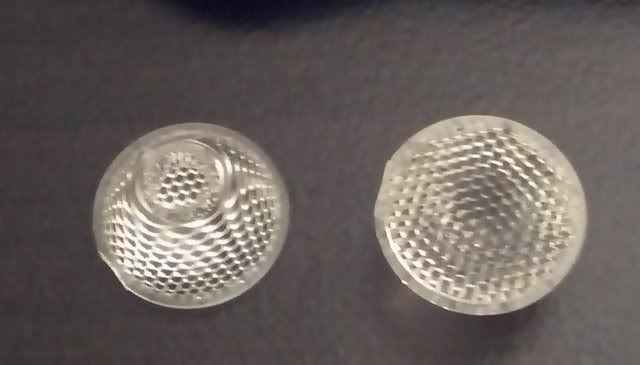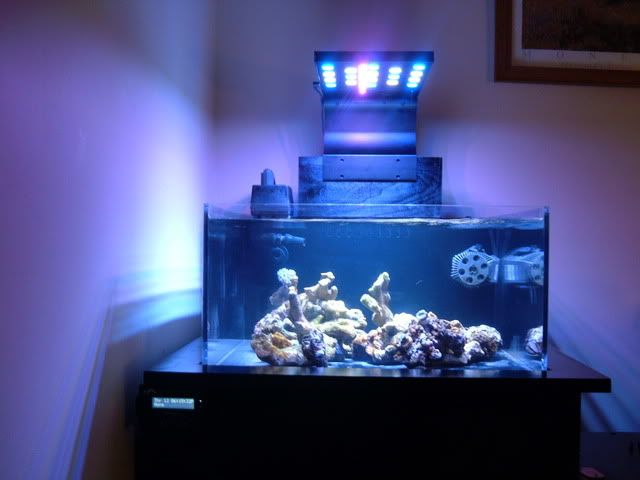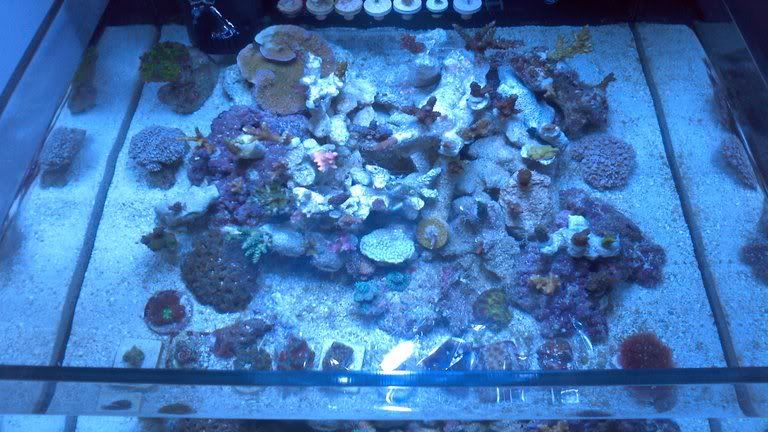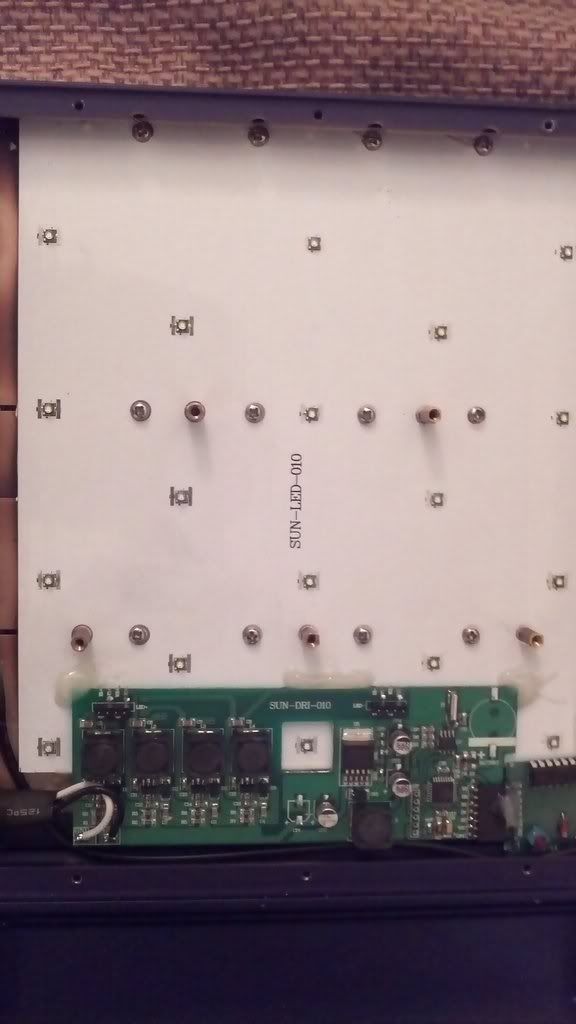Yes, what size tank is this again? I think you said 20x20x10? If the LED is right off the surface you probably don't need optics, but if you want to maximize PAR at certain depths for example, you could use optics. Also, I think you said though your up 7 inches above the surface? So, a little less than 17" from light to sand? To maximize the PAR, 60 or 80 degree would certainly work as long as you have enough LEDs to give even coverage.
Here is more than you'll ever want to know about LED optics.... It's all basic math, but still gets a bit complicated and needs to be generalized in some way.
First, assuming your considering PAR, not Lumens, then optics are what give leds their advantage over halides really. So, I'm all for optics when they are beneficial. Essentially, given total 400-700nm light output, without taking into account focusing of light, halides are still potentially more efficient than the current LEDs on the market. However, LEDs can be quite a bit more efficient if used to optimize the spread of the light.
If you really want to optimize your tank, you can calculate the spread of the lens angle at a given depth. First, though, remember this is the total area of illumination, the light will not illuminate the entire area evenly. It will be brightest in the center and then get progressively dimmer. However, wherever the leds overlap, the PAR will sum and as the PAR decreases with depth, it decreases in relation to the coverage area (not much light is actually filtered out at the depths of our tanks, it diffuses). So, for example, if the coverage area doubles, the PAR is roughly cut in half.
So, for example, if your tank is 20x20x10 and your light is 7" over, by the surface, i.e. @ 7 inches, your already covering a 24.25" circle, plus the size of the fixute, (as this is for each led). At the bottom, say 17-2" sand bed = 15", with 120 degree optics, you'd be covering a 51.96" +6"=57.96" circle. However, this gets complicated because when the light hits the glass, some will be reflected back. Every time the light reflects, you'll loose about 10-20% though. Also, you'd have roughly 30.25" of coverage at the surface of the water, as your light is 7" off the water. So, on a 20x20 tank, you'd already be losing a fair amount of light before it even gets to the tank. If your good with matlab or something you could model this, but otherwise, some generalized rule is probably somewhat necessary.
Probably a simple way to estimate what is needed is to reduce the total coverage area by some fraction. Just as an example, Evilc66 on nanotuners for example recommended once, that for their PAR bulbs, which also use CREE leds, that you reduce this area to 75% of the total for estimation. So, if your goal is to maximize PAR and cover 20"x20" completely by mid tank, and your fixture is 6"x6", then if you subtract the footprint of the fixture, you'd have 20-6=14" x 14" coverage needed at mid tank per LED. So, to maximize PAR, we need to find the angle that covers 14" at mid tank 7+(10/2)=12" the best (or instead of midtank, could use the bottom or top, or wherever you want to maximize the PAR if you use higher though, PAR will be lower, below and if you use higher, PAR will be lower above etc...).
So, at 12", (from the table below), 80 degree optics would cover 20.14" or 60deg would cover 13.86". So, reduce these by some factor, we'll use 25%, then you have 15.1" and 10.4" respectively. Then add the 6" footprint of the fixture, and we have 21.1" and 16.4" total. So, 80 would be about right at exactly this depth. 60 would have higher PAR in the center, but you'd have lower PAR to the edges, but the trade off would be that you'd have higher PAR at the bottom. Does that make sense?
For comparison, with no optics, at 12" you'd be covering a 41.57" area , or if we reduce by 25%, then a 31.2" area. Again, though some of the light would be lost before getting to the tank and some of the light would be lost when it hits the side of the tank.
Also, at any depth you'd have less PAR to begin with as the light would be more diffuse.
For example:
Compared to the 80 degree optics you'd have divide the area of a 20.14" circle by a 41.57" circle, multiply by 100 and that would be the proportion of PAR of 120degree optics vs 80 deg.
Or compared to 60 degree optics you'd have only a 13.86" circle /41.57" as far as PAR goes.
So, @12" 120 degree optics would only have about 23% of the PAR of 80 degree optics or 11% of the PAR of 60 degree optics.
Again, some light would bounce back off the glass, so, you would be a bit higher than 23% and 11% respectively, but not my huge factors. Your still loosing a lot of efficiency because your covering a larger area than needed. The moral of the story is, you can really increase PAR by optimizing the optics. Too much isn't good either though of course. A laser, puts out a lot of PAR, but won't cover the tank well; you need balance.
For reference, here is a a spreadsheet of total coverage (in inches) of common optical angles from 1-30" height.
Edit: sorry it got crunched and I don't have time to fix it, but each space lines up with each column heading.
inches 120deg 80deg 60deg 40deg
1 3.46 1.68 1.15 0.73
2 6.93 3.36 2.31 1.46
3 10.39 5.03 3.46 2.18
4 13.86 6.71 4.62 2.91
5 17.32 8.39 5.77 3.64
6 20.78 10.07 6.93 4.37
7 24.25 11.75 8.08 5.10
8 27.71 13.43 9.24 5.82
9 31.18 15.10 10.39 6.55
10 34.64 16.78 11.55 7.28
11 38.11 18.46 12.70 8.01
12 41.57 20.14 13.86 8.74
13 45.03 21.82 15.01 9.46
14 48.50 23.49 16.17 10.19
15 51.96 25.17 17.32 10.92
16 55.43 26.85 18.48 11.65
17 58.89 28.53 19.63 12.37
18 62.35 30.21 20.78 13.10
19 65.82 31.89 21.94 13.83
20 69.28 33.56 23.09 14.56
21 72.75 35.24 24.25 15.29
22 76.21 36.92 25.40 16.01
23 79.67 38.60 26.56 16.74
24 83.14 40.28 27.71 17.47
25 86.60 41.95 28.87 18.20
26 90.07 43.63 30.02 18.93
27 93.53 45.31 31.18 19.65
28 96.99 46.99 32.33 20.38
29 100.46 48.67 33.49 21.11
30 103.92 50.35 34.64 21.84





